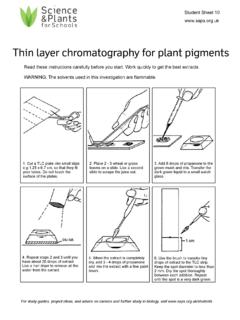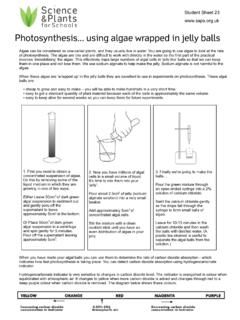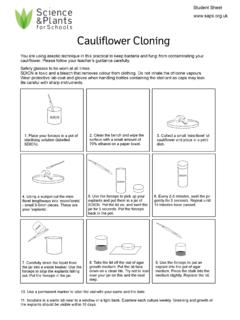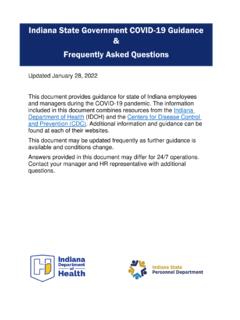Transcription of USING YOUR NOSE Smell activities for young children
1 USING YOUR NOSES mell activities for young children5-14 Environmental Studies, Science, Level BNational Curriculum, Key Stage 1, Topic - SensesUSING YOUR NOSESS mell activities for young children5-14 Environmental Studies, Science, Level B2 National Curriculum, Key Stage 1, Topic - SensesInformation for TeachersPrimary: USING Your Nose. activities on Smell for young children :This web based resource is written for 5 14 Environmental Studies, Science,Level B in Scotland and for the National Curriculum, Key Stage 1, Topic Senses,in England and Wales. It includes a set of practical activities , stories,assessments and background information for 5-7 year olds about Smell . Thereare Teacher, Technician and Pupil sheets available. All the activities are freelyavailable on the SAPS YOUR NOSESS mell activities for young children5-14 Environmental Studies, Science, Level B3 National Curriculum, Key Stage 1, Topic - SensesAcknowledgements:The authors, Pam Ferguson and Marjorie Smith, would like to thank thefollowing for their involvement with this topic:ICI, in particular, Jane Gamble, formerly Education Officer for , Science and Plants for Schools ( )Dollar Academy, particularly Primary Two classes and their teachersfor allowing us to trial the topic.
2 ( ) USING YOUR NOSESS mell activities for young children5-14 Environmental Studies, Science, Level B4 National Curriculum, Key Stage 1, Topic - SensesCONTENTST eacher and Technical GuideLesson Plans: Lesson on Smell , Gather for Conclusion, Assessment,Alternative Lesson Plans, Picture of Senses, Pictures to present atGroup WorkTeacher ResourceStory: enlarge and laminate onto A3 Picture: enlarge and laminate onto A3 Drawings of sensesActivity CardsActivities 1 4: enlarge and laminate onto A3, to be used at activitycentres/ work stationsActivity 1: with word bank for Smell collectionActivity 2: with folder with pictures of various types of noses,snouts, trunks and forked tonguesActivity 3: colour and match the word to the pictureActivity 4: match the picture to the pictureSmell Booklet for pupils (alternative pages included) activities 1 4 and the for Assessment: USING YOUR NOSESS mell activities for young children5-14 Environmental Studies, Science, Level B5 National Curriculum, Key Stage 1, Topic - SensesLESSON ON SMELLG eneral IntroductionThe following can be used as a basis for the Smell lessons.
3 As an alternative, twomore structured lesson plans sense of Smell tells us about our environment. We can Smell good things like tasty food, horrible smells like dirty socks and dangerous smells like smokefrom a fire. (could produce sets of pictures to go with this statement)Materials needed for the activities (also included in Technical Guide)film canisters, small bottles or baby food jarsselection of smells: cinnamon sticks, garlic or onion powder, red, cider andwhite vinegar, vanilla, peppermint, mixed spices, mixed herbs, rubbingalcohol, cocoa, lemon essence, coconut essence, spray perfume(those materials in bold are used in the prepared lessons)cotton ballscolouring pencilsrulerschart paperoptional: folders with picture selection of (i) animal noses, (ii) objects to fit withactivity one eg gas cookers, burning/smoking buildings, rotten foodUSING YOUR NOSESS mell activities for young children5-14 Environmental Studies, Science, Level B6 National Curriculum, Key Stage 1, Topic - SensesIntroductionWhole group gathered at circle story of the children inventing new perfumes.
4 Use chart paper/board tolist the ideas that are put forward by class during this everything have a Smell ? Pass round the baby food jars with (i) water and(ii) rubbing alcohol and (iii) white vinegar in them. Note these all look the to Smell the bottles. What do we notice now?What about these bottles? Look at second set of bottles. (These could containred vinegar, white vinegar and cider vinegar or you could also use white vinegarin this second set but colour each with different food colouring.) These all lookdifferent. What do we notice when we Smell them? They are all the same kindof board put up pictures of gas stove, burning building and rotten food. Howwould our sense of Smell help us here? Class to think about the dangers involvedand how our Smell helps us to detect these to do YOUR NOSESS mell activities for young children5-14 Environmental Studies, Science, Level B7 National Curriculum, Key Stage 1, Topic - SensesGather for ConclusionWhat are some of the important things we have learned about our sense ofsmell?
5 On chart paper list (i) good smells (ii) bad smells (iii) dangerous smellsWhen does our sense of Smell not work so well?So how do we think our noses work? USING a spray perfume, spray a little to one side of the group. Who can smellthe perfume first? Why is that?So small particles of perfume must be moving in the air and getting into ournoses. Then they tickle our nerves in our nose and the nerves send a message toour brilliant brains. Then we remember the Smell or we memorise this new the following with the group and then break to complete the (Remembering situations when our sense of Smell would help us outof danger. The Smell of smoke, for example, or rotting food perhaps.)2 USING senses together. (When we have a cold our sense of Smell is not sogood but also our sense of taste is affected.)
6 Think of the other senses used;sight, hearing, and touch.)3 Importance of Smell . ( Smell is one of the ways we have about knowing andenjoying our world. Think about Spring/Summer coming and the smells youwill come across then, like freshly cut grass or sun tan lotion.) USING YOUR NOSESS mell activities for young children5-14 Environmental Studies, Science, Level B8 National Curriculum, Key Stage 1, Topic - SensesLesson 1 - SmellGather as GroupToday we are going to think about our senses. What are these?Here are some clues. (Use the drawings of senses).Seeing/Hearing/Touching/Tasting/ SmellingWe are going to concentrate on one sense. Our sense of with story. Place the picture on a storyboard. Read the story aloud to group.(Possible answers to questions)What would like the Smell of a fish?
7 Cat/seagull/osprey/bearWho likes the Smell of a bone? Dog/wolf/lionCan you invent some names for the new perfumes in the lemon, apples, flowers, group activity together1 Pass round the vinegar/alcohol/water bottles. Look the same but round the second set of bottles containing three types of colours but this time Smell the our noses are good at telling the difference between smells. Our noses alsohelp us detect pictures/discuss ideas such as:Smelling smoke from a burning building, or a gas leak from a stove or rottenfood from good look at our Smell booklets. Return to seats to begin to look and complete through booklet once as class. Explain Activity 1. Suggest teacher only hasone practical activity going on at one time ie save Activity 2 for the secondlesson.
8 The rest of the class can complete Activity 3 and 4 on their own, 1 Three/four people can go to this centre at one time. They will Smell the samplesthere and see if they can detect what the Smell is. Look at the words to YOUR NOSESS mell activities for young children5-14 Environmental Studies, Science, Level B9 National Curriculum, Key Stage 1, Topic - SensesActivity 2 Four people can do this activity at one time. Here we look at different animals use a snout, like the pig. Some animals use a trunk, like theelephant. Some animals use a forked tongue to Smell with, like the snake. Someinsects, like the butterfly, the fly and the moth use their antenna andsometimes their feet to Smell with. Some of the noses you ll find in the packetwill not fit the groups you are given.
9 For these you will have to count all the 3 Use your colours carefully and repeat the pattern on each side of the the words to the 4 Match the favourite Smell to the animal. Then draw your own animal and Smell -match in the boxes left you see a space at an activity you can go and do that will also have the story picture to YOUR NOSESS mell activities for young children5-14 Environmental Studies, Science, Level B10 National Curriculum, Key Stage 1, Topic - SensesGather as GroupToday we are going to finish off our work on the sense of have we learned so far about Smell ?On chart paper/boardList good smells/bad smells/smells that tell us of danger, USING responses from does our sense of Smell not work so well?(When we have a cold)How do our noses work?Use spray bottle with perfume.
10 Spray to side of can Smell the perfume first?Why is that? Discuss movement of drops/particles/droplets in the air fromwhere there is lots of the perfume to where there is drops of perfume must be able to move in the air and get up into ournoses. Then they tickle our nerves in our nose and these nerves send a messageto our brains. We remember the Smell or we learn a new return to seats and work on remaining we have finished the activities still to do, we will have a little over what has still to be Pupils to finish Activity 12 Pupils to finish Activity 23 Concentrate on finishing activities 3 and 4 if you have done all the otheractivities. When you have finished all four activities you can go onto theword search or complete the big colour picture from the over each area of the assessment.












